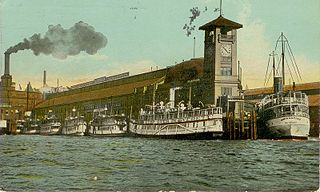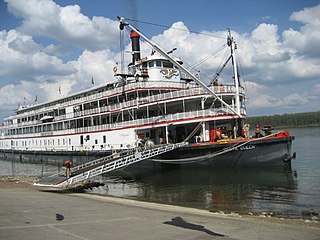
Sultana was a commercial side-wheel steamboat which exploded and sank on the Mississippi River on April 27, 1865, killing 1,167 people in what remains the worst maritime disaster in United States history.

SS Princess Alice, formerly PS Bute, was a British passenger paddle steamer that sank on 3 September 1878 after a collision with the collier SS Bywell Castle on the River Thames. Between 600 and 700 people died, all from Princess Alice, the greatest loss of life of any British inland waterway shipping accident. No passenger list or headcount was made, so the exact figure of those who died has never been known.

SS Andrea Doria was a luxury transatlantic ocean liner of the Italian Line, put into service in 1953. She is widely known from the extensive media coverage of her sinking in 1956, which included the remarkably successful rescue of 1,660 of her 1,706 passengers and crew.

The PS General Slocum was a sidewheel passenger steamboat built in Brooklyn, New York, in 1891. During her service history, she was involved in a number of mishaps, including multiple groundings and collisions.

The Lexington was a paddlewheel steamboat operating along the Northeastern coast of the United States from 1835 to 1840. Commissioned by Cornelius Vanderbilt, it was one of the fastest and most luxurious steamers in operation.

The MV George Prince ferry disaster was a nautical disaster that occurred in the Mississippi River in St. Charles Parish, Louisiana, United States, on the morning of October 20, 1976. The Luling–Destrehan Ferry George Prince was struck by the Norwegian tanker SS Frosta, which was traveling upriver. The collision occurred at mile post 120.8 above Head of Passes, less than three-quarters of a mile from the construction site of the Luling Bridge which would replace the ferry seven years later. The ferry was crossing from Destrehan, Louisiana on the East Bank to Luling, Louisiana on the West Bank. Ninety-six passengers and crew were aboard the ferry when it was struck, and seventy-eight perished. This accident is the deadliest ferry disaster in United States history. It is also the deadliest peacetime nautical disaster involving a non-submersible vessel in U.S. waters since the explosion of the SS Grandcamp in 1947, which killed 581 people. In addition, it is the deadliest accident involving a single vessel in U.S waters since a fire on board the SS Morro Castle in 1934, which killed 137 people.

SS Pacific was a wooden sidewheel steamer built in 1850 most notable for its sinking in 1875 as a result of a collision southwest of Cape Flattery, Washington. Pacific had an estimated 275 passengers and crew aboard when she sank. Only two survived. Among the casualties were several notable figures, including the vessel's captain at the time of the disaster, Jefferson Davis Howell (1846–1875), the brother-in-law of former Confederate President Jefferson Davis. The sinking of Pacific killed more people than any other marine disaster on the West Coast at the time.

The Puget Sound mosquito fleet was a multitude of private transportation companies running smaller passenger and freight boats on Puget Sound and nearby waterways and rivers. This large group of steamers and sternwheelers plied the waters of Puget Sound, stopping at every waterfront dock. The historical period defining the beginning and end of the mosquito fleet is ambiguous, but the peak of activity occurred between the First and Second World Wars.

RMS Titanic sank in the early morning hours of 15 April 1912 in the North Atlantic Ocean, four days into her maiden voyage from Southampton to New York City. The largest ocean liner in service at the time, Titanic had an estimated 2,224 people on board when she struck an iceberg at around 23:40 on Sunday, 14 April 1912. Her sinking two hours and forty minutes later at 02:20 ship's time on Monday, 15 April, resulted in the deaths of more than 1,500 people, making it one of the deadliest peacetime maritime disasters in history.

Natchez has been the name of several steamboats, and four naval vessels, each named after the city of Natchez, Mississippi or the Natchez people. The current one has been in operation since 1975. The previous Natchez were all operated in the nineteenth century, most by Captain Thomas P. Leathers. Each of the steamboats since Leathers' first had as its ensign a cotton bale between its stacks.

President is a steamboat that currently lies dismantled in Effingham, Illinois, United States. Originally named Cincinnati, it was built in 1924 and is the only remaining "Western Rivers" style sidewheel river excursion steamboat in the United States. She was listed on the National Register of Historic Places and declared a National Historic Landmark in 1989, although these designations were revoked in 2011. Her home ports have been Cincinnati, Ohio; New Orleans, Louisiana; Vicksburg, Mississippi; St. Louis, Missouri; and Davenport, Iowa.

The steamboat Dix operated from 1904 to 1906 as part of the Puget Sound Mosquito Fleet. She was sunk in a collision which remains one of the most serious transportation accidents in the state of Washington to this day.

Flyer was an American steamboat that served from 1891 to 1929 on Puget Sound. From 1918 until the end of her service, she was officially known as the Washington. The Flyer ran for millions of miles at high speed, more than any inland vessel in the world. This 1891 steamer Flyer should not be confused with the steamboat Flyer built on Lake Coeur d'Alene in 1905, although the Coeur d'Alene vessel was inspired both in design and name by the success of the Puget Sound ship.

Steamboats played a major role in the 19th-century development of the Mississippi River and its tributaries, allowing practical large-scale transport of passengers and freight both up- and down-river. Using steam power, riverboats were developed during that time which could navigate in shallow waters as well as upriver against strong currents. After the development of railroads, passenger traffic gradually switched to this faster form of transportation, but steamboats continued to serve Mississippi River commerce into the early 20th century. A small number of steamboats are still used for tourist excursions in the 21st century.

The Lucy Walker steamboat disaster was an 1844 steamboat accident caused by the explosion of the boilers of the steamboat Lucy Walker near New Albany, Indiana, on the Ohio River. The explosion occurred on the afternoon of Wednesday, October 23, 1844, when the steamer's three boilers exploded, set the vessel on fire, and sank it. It was one of a number of similar accidents of early 19th-century riverine transportation that led to important federal legislation and safety regulations. The vessel's owner was a Native American; her crew were African-American slaves, and her passengers represented a cross-section of frontier travelers.
The Eliza Battle was a Tombigbee River steamboat that ran a route between Columbus, Mississippi and Mobile, Alabama in the United States during the 1850s. She was destroyed in a fire on the river near modern Pennington, Alabama on March 1, 1858. It was the greatest maritime disaster in Tombigbee River history, with an estimated thirty-three people killed, out of roughly sixty passengers and a crew of forty-five. The disaster and its aftermath saw the Eliza Battle enter southwestern Alabama folklore as a ghost ship, with numerous purported sightings of the burning ship from just north of Pennington to Nanafalia downriver. The story of the disaster and associated folklore has been fictionalized in several published short stories, most notably in “The Phantom Steamboat of the Tombigbee” in 13 Alabama Ghosts and Jeffrey.

Lifeboats played a crucial role during the sinking of the Titanic on 14–15 April 1912. The ship had 20 lifeboats that, in total, could accommodate 1,178 people, a little over half of the 2,209 on board the night it sank.

Far West was a shallow draft sternwheel steamboat plying the upper Missouri and Yellowstone Rivers in the Dakota and Montana Territories, in the years from 1870 to 1883. By being involved in historic events in the Indian Wars of the western frontier, the Far West became an iconic symbol of the shallow draft steamboat plying the upper Missouri and Yellowstone Rivers in the era before railroads dominated transport in these areas.

Racer's hurricane was a destructive tropical cyclone that had severe effects in northeastern Mexico, the Republic of Texas, and the Gulf Coast of the United States in early October 1837. It was named after the Royal Navy ship HMS Racer, which encountered the cyclone in the northwestern Caribbean. Termed "one of the most famous and destructive hurricanes of the century" by meteorology historian David Ludlum, the storm first affected Jamaica with flooding rainfall and strong winds on September 26 and 27, before entering the Gulf of Mexico by October 1. As the hurricane struck northern Tamaulipas and southern Texas, it slowed to a crawl and turned sharply northeastward. The storm battered the Gulf Coast from Texas to the Florida Panhandle between October 3 and 7. After crossing the Southeastern United States, it emerged into the Atlantic shipping lanes off the Carolinas by October 9.

Lloyd's Steamboat Directory, and Disasters on the Western Waters is a book published in 1856 listing steamboat businesses in the United States, along with an illustrated catalog of American maritime disasters. It covers "mainly river material, with a substantial scattering of lake items."



















